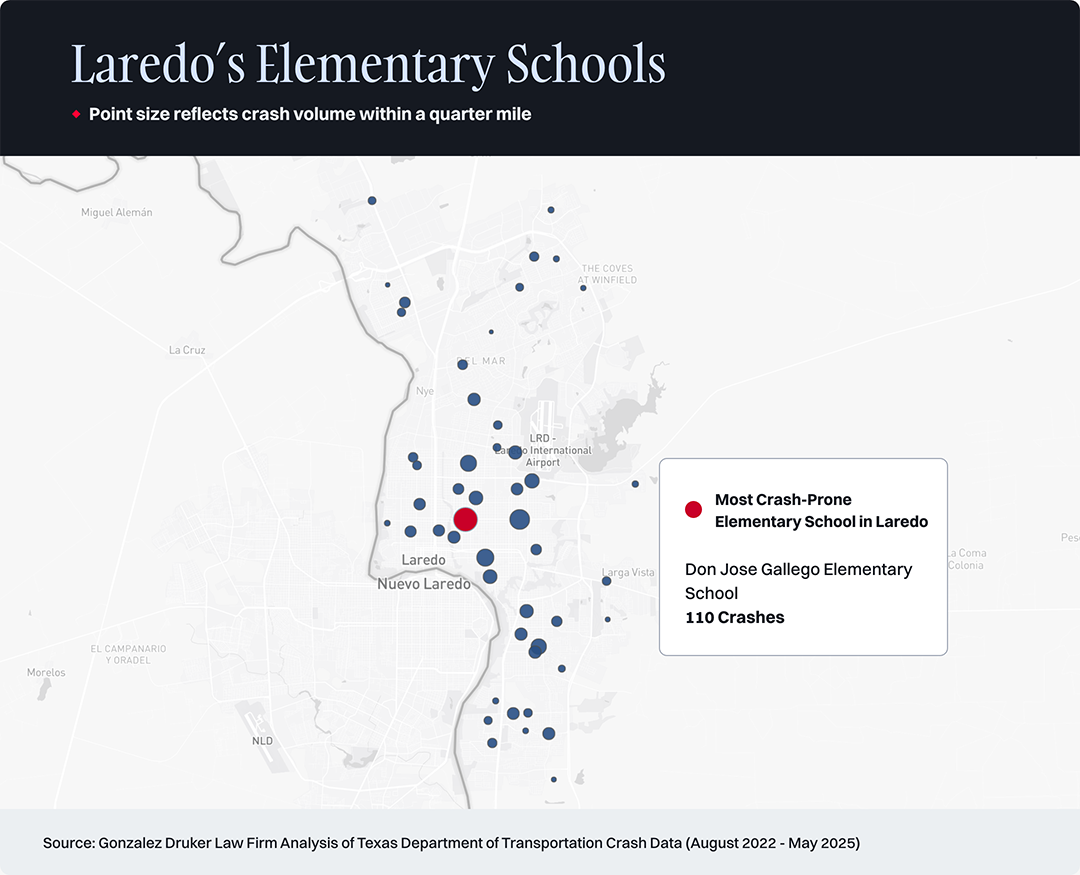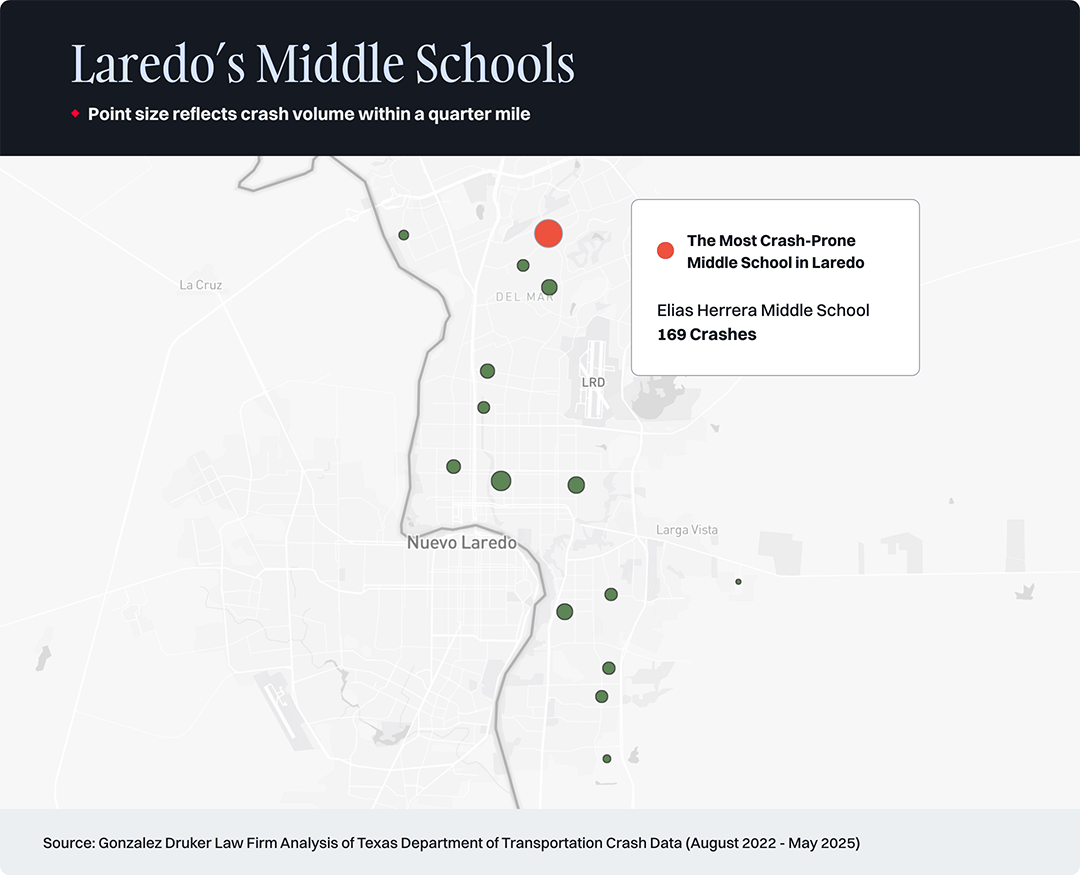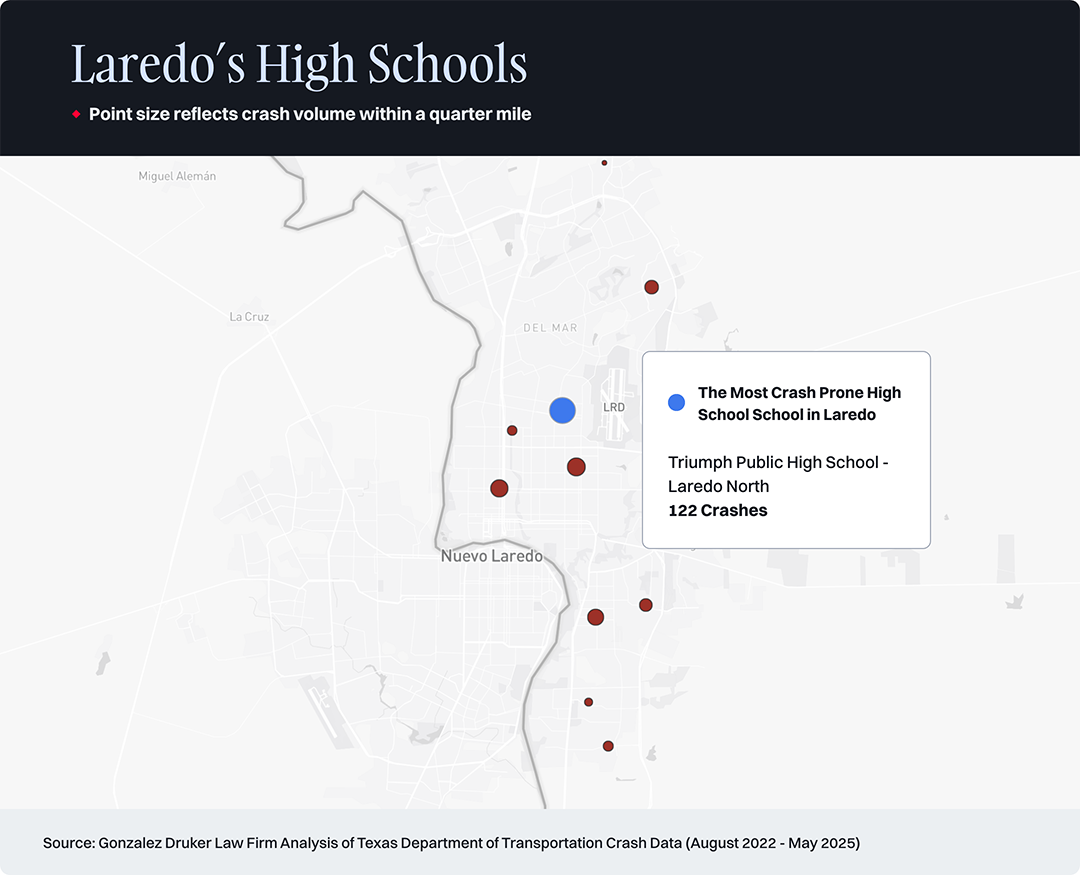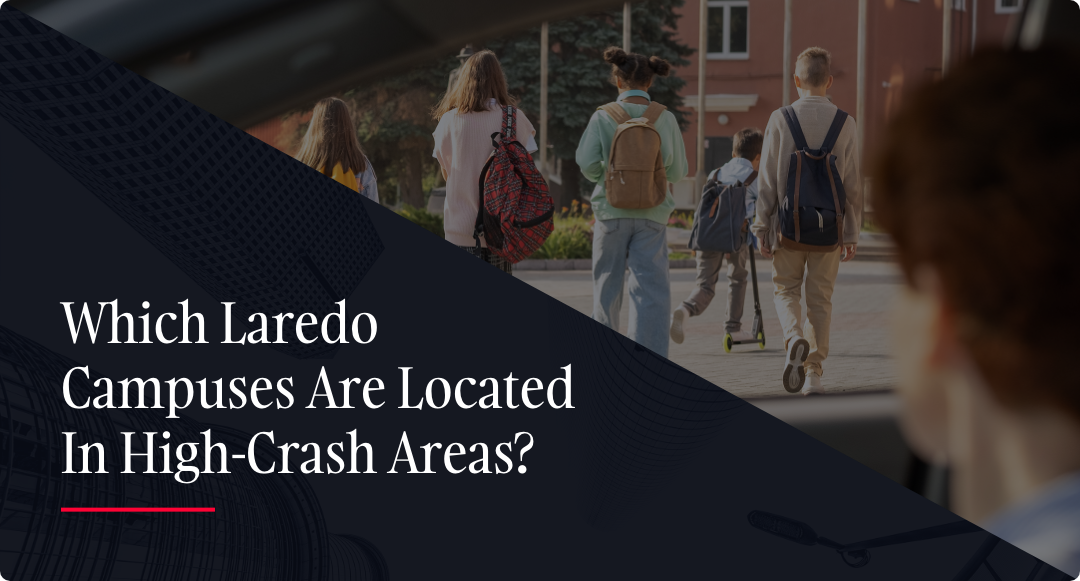Key Takeaways
- The area around Don Jose Gallego Elementary saw the most crashes near any elementary school in Laredo, with 110 incidents and 37 injuries in a three year span.
- Elias Herrera Middle School recorded the highest crash count near any middle school, with 169 crashes and 43 injuries between 2022 and 2025.
- Triumph Public High School had the most crashes of any high school campus, totaling 122, while Joseph W. Nixon High School reported the highest injury count at 51.
- Dr. Leonides G. Cigarroa High School reported the most pedestrian-involved incidents of any school, with five in total.
- Kennedy-Zapata Elementary, Freedom Elementary, Raul Perales Middle School reported zero crashes during the three-year study period.
- Speeding was the top contributing factor in school bus crashes, linked to 23 incidents and 65 injuries.
Traffic near schools can be overwhelming. Cars pulling in and out, students crossing the street, and parents trying to stay on schedule all contribute to a busy and often tense environment. With so much activity packed into the school day, crashes are a real concern.
To better understand where incidents are happening most around Laredo’s schools, we analyzed crash data from the Texas Department of Transportation. We looked at crashes that occurred between 6:30 a.m. and 5:30 p.m. on school days, from August 2022 through May 2025. Every crash within a quarter-mile of a school was included in the analysis. We refer to these quarter-mile radius areas as ‘School Transit Zones’ — a term used to describe locations where school-related traffic is likely, even beyond the boundaries of official school zones. Unlike state-designated school zones, which are typically limited to marked areas with reduced speed limits during specific times, our School Transit Zones capture a broader range of traffic activity connected to student drop-offs, pickups, and commuting. Based on traffic patterns, we determined that crashes up to a quarter-mile away could still be influenced by school transit.
School location data was sourced from the Texas Education Agency Public Open Data Site. Each school is ranked by total crash count, with additional details on injuries, fatalities, and pedestrian-involved incidents to highlight where traffic risks are highest. We included an interactive map, where each school type (Elementary, middle, and high school) are represented by a different color, and point size reflects the number of crashes. We also analyze school bus crashes in Laredo and the most common contributing factors.
Interactive Map: Laredo’s Crash-Prone Schools
The map below displays Laredo schools using color-coded points: blue for elementary schools, red for middle schools, and green for high schools. In some cases, nearby schools may share crash counts due to overlapping School Transit Zones, meaning some incidents may appear in the totals for more than one school. Still, each school’s data reflects the conditions in its immediate surroundings and highlights where traffic risks and student safety concerns may be most pressing. Point size corresponds to the number of crashes, with larger points indicating more incidents. Hover over any point to view detailed information.
Elementary School Crash Safety
Elementary campuses are typically surrounded by high levels of drop-off and pick-up activity, making them hotspots for traffic congestion. The table below shows which elementary schools experienced the most crashes during school hours and how often those incidents led to injuries or other serious outcomes.


Between August 2022 and May 2025, Don Jose Gallego Elementary School experienced the highest number of crashes in its vicinity, with 110 incidents occurring within a quarter mile during school hours. These crashes resulted in 37 injuries, one pedestrian-involved incident, and one of two of the only fatalities recorded near any Laredo elementary school during the study period.
Michael S. Ryan Elementary and Heights Elementary followed, with 93 and 70 crashes respectively. Both schools had a relatively high number of injuries, and each saw at least one pedestrian-involved crash. Further down the list, Henry B. Zachry Elementary stood out with the highest number of pedestrian-involved incidents (2), despite ranking fifth in overall crash count.
Some schools lower on the list had concerning statistics despite fewer crashes. D.D. Hachar Elementary, for example, saw just 27 crashes but recorded one fatality and two pedestrian-related incidents. Located near busy commercial routes, this setting may explain why it had outcomes more severe than schools with twice the number of crashes.
At the bottom of the list, Kennedy-Zapata and Freedom Elementary reported no crashes during the study period. These campuses are situated in quieter parts of the city with fewer traffic pressures, which may be helping to keep students, parents and staff safer.
Middle School Crash Safety
Next, we examined middle schools, where students often begin walking or biking independently. The following table shows where traffic risks were highest and how those risks translated into injuries and pedestrian incidents.


The area surrounding Elias Herrera Middle School saw more traffic incidents than any other middle school in Laredo, with 169 crashes reported over the three-year period. Although none involved pedestrians or resulted in fatalities, the total number of injuries (43) was the highest among all middle schools. Located near Guadalupe and the downtown corridor, the school sits in one of the city’s more congested zones, where activity is constantly in motion.
Memorial Middle School ranked second, with 86 crashes and 37 injuries. It had a notable number of pedestrian-involved incidents, with four in total, indicating more direct risks to students traveling on foot. Two other schools, Dr. Joaquin G. Cigarroa Middle School and Mirabeau B. Lamar Middle School, also saw pedestrian-related incidents. Cigarroa matched Memorial with four pedestrian-involved crashes despite having fewer total collisions. Lamar had one pedestrian-involved crash and 16 injuries out of 53 total crashes. These patterns suggest areas where additional crossing protections may be needed to prevent more Laredo pedestrian accidents.
On the opposite end, Raul Perales Middle School recorded zero crashes throughout the entire study period.
High School Crash Safety
High school campuses tend to see more vehicle traffic, with student drivers, increased after-school activity, and larger parking lots. The table below breaks down crash data for each high school in Laredo, including injury totals and pedestrian involvement.


Among Laredo high schools, Triumph Public High School recorded the highest number of crashes, with 122 incidents and 40 injuries over the three-year study period. Two pedestrian-involved crashes were also reported.
Joseph W. Nixon High School followed closely with 70 crashes, yet it surpassed all other high schools in injury count with 51. It also had two pedestrian-involved incidents. In fact, a severe pedestrian crash near Nixon High in late 2023 made local news when a student was struck while crossing the street. Dr. Leonides G. Cigarroa High School stood out for reporting the highest number of pedestrian-involved incidents, with five in total.
At the lower end of the list, United High School reported just four crashes with no injuries or pedestrian incidents. Similarly, Triumph Public High Schools recorded 13 crashes but no injuries. These schools may benefit from less traffic exposure or safer surrounding road design.
School Bus Crashes
From August 2022 to May 2025, there were 119 school bus crashes reported in Laredo. Of these, nearly one in five resulted in injuries. While most resulted in no harm, about 69% of the incidents led to property damage exceeding $1,000. Below are the five most common contributing factors.
Backing up without properly checking for safety was the second most common issue, involved in 16 crashes and 17 injuries. It led to high-cost property damage in half of those cases. This behavior is especially concerning in areas such as school grounds or residential neighborhoods, where visibility and proximity to pedestrians require greater vigilance.
Other significant contributors included unsafe lane changes (11 crashes), failure to yield at stop signs (7 crashes and 27 injuries), and failure to drive in a single lane (7 crashes). The incident that resulted in the most injuries involved a failure to yield the right of way at a stop sign, where limited visibility played a key role. All crashes of this violation also caused significant property damage. The intersection setting likely contributed to the severity, as crashes at crossings tend to be more dangerous. When a school bus accident results in excessive property damage and or injuries, victims can file a Laredo accident claim to pursue compensation.
What Parents and Students Can Do
While some campuses recorded more crashes or injuries than others, the reality is that every school zone — and the areas surrounding it — can pose risks, especially during busy drop-off and pick-up times. Crashes occurred throughout Laredo’s school network, making safety a shared responsibility for drivers, parents, and students alike.
One important factor behind many of these incidents is driver mindset. When people are rushed, stressed, or distracted, they’re more likely to speed, miss signs, or glance at their phones. These small lapses can have serious consequences near schools. That’s why it’s worth building extra time into your morning or afternoon routine. Arriving calm, focused, and alert helps prevent mistakes and keeps everyone safer.
Parents should use designated drop-off areas, avoid letting children exit the vehicle mid-street, and remain alert for students walking or biking through crosswalks or parking lots. Reinforcing pedestrian safety at home is also essential. Encourage kids to use sidewalks, obey crossing signals, and make eye contact with drivers before stepping into the street.
For students walking or biking to school, staying aware of their surroundings is key. Avoid distractions like phones or headphones, stick to marked crossings, and always assume drivers may not see you — even in school zones. Students who drive themselves should silence their phones, keep music at a reasonable volume, and resist the urge to speed or beat traffic lights. Above all, everyone should follow school safety procedures and traffic laws. A little more patience and preparation during school hours can go a long way in preventing crashes and protecting lives.
Finally, the maps and rankings in this report highlight where crashes are most common. Parents, educators, and city officials can use this data to identify the most crash-prone areas. This data can guide changes in daily routines or even support calls for improved signage, crosswalks, or enforcement. By combining better awareness with action, the community can work together to create safer routes.
If you or a loved one has suffered injuries from an accident near a school, don’t hesitate to contact our Laredo injury lawyer. We will assess your case for free and help you pursue a claim if that is the best course of action.
Methodology
We analyzed crash data from the Texas Department of Transportation for incidents occurring between 6:30 a.m. and 5:30 p.m. on school days from August 2022 to May 2025. All crashes within a quarter-mile of schools in Laredo were included. The summer months of June and July were excluded. Highway crashes were also excluded. School locations came from the Texas Education Agency Public Open Data Site. Schools were ranked by total crashes, injuries, fatalities, and pedestrian-involved incidents. Because the quarter-mile zones can overlap between nearby schools, some crashes may be counted for multiple schools. Despite this, the data helps identify which schools have higher crash risks around them. We also reviewed school bus crashes in Laredo during this period and identified common contributing factors.
Fair Use Statement
Know someone who might be interested in this study? Feel free to share it! If you plan to reference our findings, we kindly ask that you include a link to the original source. Proper attribution encourages accurate reporting and allows others to explore the complete data in context.

